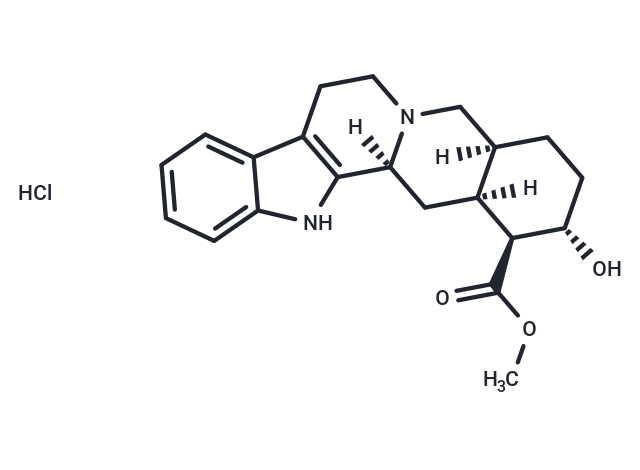- Remove All
 Your shopping cart is currently empty
Your shopping cart is currently empty
Shopping Cart
Rauwolscine hydrochloride
Catalog No. T4429Cas No. 6211-32-1
Alias α-Yohimbine hydrochloride, Isoyohimbine hydrochloride, Corynanthidine hydrochloride
Rauwolscine hydrochloride (Isoyohimbine hydrochloride) , a natural alkaloid, is a specific and reversible α2-adrenergic receptor antagonist (Ki: 12 nM) [1]. It is a stereoisomer of yohimbine, which potently antagonizes both α1- and α2-adrenergic receptors [1]. Rauwolscine hydrochloride also acts as a receptor antagonist at the serotonin 5-HT2B receptor (Ki: 14.3 nM) and as a weak partial agonist at 5-HT1A (IC50: 1.3 μM) [3]. The α2-adrenergic receptor has diverse physiological functions and antagonists like rauwolscine have numerous applications, including the modulation of mood and behavior [5].

Rauwolscine hydrochloride
Catalog No. T4429Alias α-Yohimbine hydrochloride, Isoyohimbine hydrochloride, Corynanthidine hydrochlorideCas No. 6211-32-1
Rauwolscine hydrochloride (Isoyohimbine hydrochloride) , a natural alkaloid, is a specific and reversible α2-adrenergic receptor antagonist (Ki: 12 nM) [1]. It is a stereoisomer of yohimbine, which potently antagonizes both α1- and α2-adrenergic receptors [1]. Rauwolscine hydrochloride also acts as a receptor antagonist at the serotonin 5-HT2B receptor (Ki: 14.3 nM) and as a weak partial agonist at 5-HT1A (IC50: 1.3 μM) [3]. The α2-adrenergic receptor has diverse physiological functions and antagonists like rauwolscine have numerous applications, including the modulation of mood and behavior [5].
| Pack Size | Price | Availability | Quantity |
|---|---|---|---|
| 50 mg | 47 € | In Stock | |
| 1 mL x 10 mM (in DMSO) | 47 € | In Stock |
Bulk & Custom
Add to Cart
Questions
View MoreSelect Batch
Purity:100%
Contact us for more batch information
All TargetMol products are for research purposes only and cannot be used for human consumption. We do not provide products or services to individuals. Please comply with the intended use and do not use TargetMol products for any other purpose.Product Introduction
Bioactivity
Chemical Properties
| Description | Rauwolscine hydrochloride (Isoyohimbine hydrochloride) , a natural alkaloid, is a specific and reversible α2-adrenergic receptor antagonist (Ki: 12 nM) [1]. It is a stereoisomer of yohimbine, which potently antagonizes both α1- and α2-adrenergic receptors [1]. Rauwolscine hydrochloride also acts as a receptor antagonist at the serotonin 5-HT2B receptor (Ki: 14.3 nM) and as a weak partial agonist at 5-HT1A (IC50: 1.3 μM) [3]. The α2-adrenergic receptor has diverse physiological functions and antagonists like rauwolscine have numerous applications, including the modulation of mood and behavior [5]. |
| Targets&IC50 | α2-adrenoceptor:12 nM (Ki) |
| In vitro | [3H]Rauwolscine binding to the α2 adrenergic receptor is reversible, stcreospccific, and saturable. [3H]Rauwolscine specifically labels both the high and low-affinity states of the α2 adrenergic receptor in brain membranes[1]. [3H]Rauwolscine also behaves as a 5-HT1A receptor agonist, indicating that rauwolscine (as well as yohimbine) has agonistic properties at the level of 5-HT autoreceptors[2]. When using [3H]5-HT as a radioligand, rauwolscine is determined to have a relatively high affinity for the human receptor (Ki: 14.3/35.8 nM, for human and rat)[3]. Saturation studies show that the affinity of [3H]Rauwolscine is similar in mouse, rabbit, rat, dog (2.33-3.03 nM) except man where it is significantly higher (0.98 nM) [4]. |
| Kinase Assay | Fresh bovine frontal cortex is incubated in triplicate with [3H]Rauwolscine (82 Ci/mM, diluted). Incubation is terminated by filtration under reduced pressure over filters, which are then rinsed with ice-cold Tris-HCl buffer, dried overnight and added to disposable glass mini vials containing 3.0 mL of a 95% Econofluor/5% Protocol solution. Samples are counted by liquid scintillation spectrometry with an efficiency of 32%. (-)- [3H]Epinephrine binding to bovine cortex membranes is conducted at 25°C[1]. |
| Alias | α-Yohimbine hydrochloride, Isoyohimbine hydrochloride, Corynanthidine hydrochloride |
| Molecular Weight | 390.9 |
| Formula | C21H27ClN2O3 |
| Cas No. | 6211-32-1 |
| Smiles | Cl.[H][C@]12CC[C@H](O)[C@@H](C(=O)OC)[C@@]1([H])C[C@]1([H])N(CCc3c1[nH]c1ccccc31)C2 |
| Relative Density. | 1.31 g/cm3 |
Storage & Solubility Information
| Storage | Powder: -20°C for 3 years | In solvent: -80°C for 1 year | Shipping with blue ice. | ||||||||||||||||||||||||||||||
| Solubility Information | DMSO: 13.75 mg/mL (35.18 mM), Heating is recommended. H2O: 5 mM, Heating is recommended. | ||||||||||||||||||||||||||||||
Solution Preparation Table | |||||||||||||||||||||||||||||||
H2O/DMSO
DMSO
| |||||||||||||||||||||||||||||||
Calculator
In Vivo Formulation Calculator (Clear solution)
Please enter your animal experiment information in the following box and click Calculate to obtain the mother liquor preparation method and in vivo formula preparation method:
Mother liquor preparation method: 2 mg of drug dissolved in 50 μL DMSO (mother liquor concentration of 40 mg/mL), if you need to configure a concentration that exceeds the solubility of the product, please contact us first.
(mother liquor concentration of 40 mg/mL), if you need to configure a concentration that exceeds the solubility of the product, please contact us first.
Preparation method for in vivo formula: Take 50 μL DMSO main solution, add 300 μLPEG300
main solution, add 300 μLPEG300 mix well and clarify, then add 50 more μL Tween 80, mix well and clarify, then add 600 more μLddH2O
mix well and clarify, then add 50 more μL Tween 80, mix well and clarify, then add 600 more μLddH2O mix well and clarify
mix well and clarify
For Reference Only. Please develop an appropriate dissolution method based on your laboratory animals and route of administration.
Dose Conversion
You can also refer to dose conversion for different animals. More Dose Conversion
Tech Support
Please see Inhibitor Handling Instructions for more frequently ask questions. Topics include: how to prepare stock solutions, how to store products, and cautions on cell-based assays & animal experiments, etc
Keywords
α-Yohimbine Hydrochlorideα-Yohimbineα2 adrenergic receptorRauwolscine hydrochlorideRauwolscine HydrochlorideRauwolscineIsoyohimbine HydrochlorideIsoyohimbineInhibitorinhibitCorynanthidine HydrochlorideCorynanthidineBeta Receptora-Yohimbine Hydrochloridealpha-Yohimbine HydrochlorideAdrenergicReceptorAdrenergic Receptor
Related Tags: buy Rauwolscine hydrochloride | purchase Rauwolscine hydrochloride | Rauwolscine hydrochloride cost | order Rauwolscine hydrochloride | Rauwolscine hydrochloride chemical structure | Rauwolscine hydrochloride in vitro | Rauwolscine hydrochloride formula | Rauwolscine hydrochloride molecular weight

Copyright © 2015-2024 TargetMol Chemicals Inc. All Rights Reserved.



